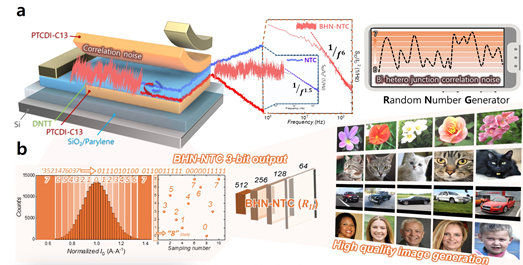Enhancing generative AI image quality through superimposed noise characteristics at heterojunction interfaces

A research team led by Professor Yoo Ho-cheon from the Department of Electronic Engineering at Hanyang University has developed a “single-transistor-based true random number generator” that utilizes the superimposed electrical noise phenomenon occurring at two heterojunction interfaces to generate unpredictable true random numbers (TRNs).
The developed device employs the negative transconductance (NTC) characteristic, a phenomenon where current decreases despite an increase in input voltage within a specific voltage range. Thanks to this feature, the new TRNG achieves a far simpler structure and higher energy efficiency than conventional win 토토사이트 number generators and is expected to find applications in AI semiconductors, security, and various next-generation computing technologies.
Traditional software-based random number generators rely on a seed value, which determines the entire random number sequence, thus limiting unpredictability and performance. Although digital circuit-based TRNGs have been developed to address this, they rely on physical noise, leading to complex circuitry and high energy consumption—major bottlenecks in implementation.
To solve these technical challenges, the research team designed a multi-heterojunction semiconductor structure incorporating PTCDI-C13 as an auxiliary layer to improve electron injection properties. This structure effectively converts independently generated and superimposed noise at heterojunction interfaces into digital win 토토사이트 numbers. As a result, the device can directly output 3-bit digital win 토토사이트 numbers at the single-device level, without the need for external computational circuits or post-processing steps.
The generated win 토토사이트 numbers were successfully used as input for a generative AI model (Style GAN 2), enabling the creation of high-quality virtual images across various classes, including cats, humans, flowers, and cars. This demonstrated the practical application potential of the developed device.
Furthermore, the team enhanced electron injection and improved the NTC transistor characteristics, enabling clear differentiation of three output states in ternary logic circuits. This advancement significantly improves both the accuracy and stability of digital computations.

Professor Yoo Ho-cheon, the lead researcher, stated, “This study represents a pioneering example of implementing both true random number generation and digital computing in a single device, leading the way in AI semiconductor technology.” He added, “It is expected to serve as a strategic technology for hardware-based AI computation in fields such as generative AI, computing operations, and low-power edge computing.”
This research was supported by the Ministry of Science and ICT and the Institute of Information & Communications Technology Planning & Evaluation (IITP) through the AI Semiconductor Talent Development Program under the ICT & Broadcasting Innovation Talent Development initiative. The results were published in the June issue of Advanced Materials (IF: 26.8, top 2.2% in JCR) under the title “Heterojunction-Driven Stochasticity: Bi-Heterojunction Noise-Enhanced Negative Transconductance Transistor in Image Generation.” Han Young-min, a PhD candidate at Hanyang University, served as first author, Song Jae-chan, an integrated master’s and doctoral program student, as co-first author, and Professor Yoo as the corresponding author.
